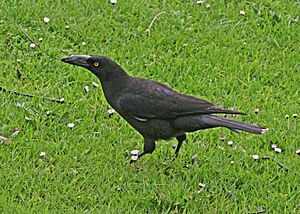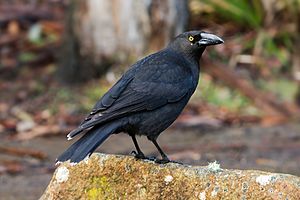Black currawong facts for kids
Quick facts for kids Black currawong |
||||
|---|---|---|---|---|
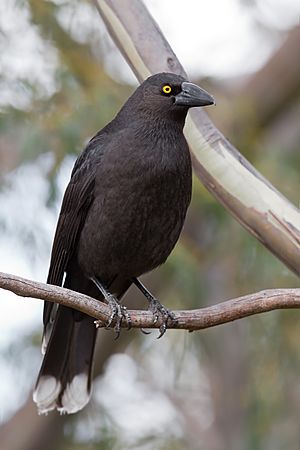 |
||||
| Black currawong, Tasmania | ||||
| Conservation status | ||||
| Scientific classification | ||||
| Genus: |
Strepera
|
|||
| Species: |
fuliginosa
|
|||
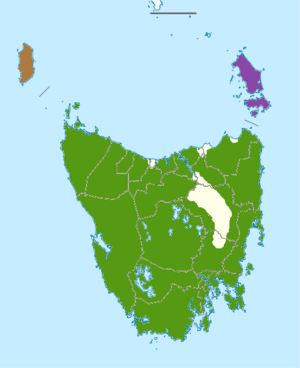 |
||||
| Black currawong range subspecies indicated
|
||||
The black currawong (Strepera fuliginosa) is a large, crow-like bird found only in Tasmania and nearby islands. People sometimes call it the black jay. It's one of three currawong species and is related to butcherbirds and the Australian magpie.
This bird is about 50 cm (20 in) long. It has bright yellow eyes, a strong bill, and black feathers with white patches on its wings. Both male and female black currawongs look similar. There are three types, or subspecies, of black currawongs. One of them, Strepera fuliginosa colei from King Island, is in danger of disappearing.
Black currawongs usually stay in one area. However, those living in high mountains might move to lower places when it gets cold. They prefer thick forests and mountain heathland. You won't often find them below 200 m (660 ft) in height. These birds eat many different things, like berries, invertebrates (bugs), and small animals. They spend more time looking for food on the ground than their relatives, the pied currawongs. They sleep and build their nests in trees.
Contents
About the Black Currawong
What's in a Name?
The black currawong was first described by a bird expert named John Gould in 1836. He gave it the scientific name Cracticus fuliginosus. The word fuliginosus comes from a Latin word meaning "sooty," which describes its black feathers.
Some common names for this bird include sooty currawong, black bell-magpie, and black or mountain magpie. In Tasmania, people often call it the black jay. It can sometimes be confused with the "clinking currawong," which is a type of grey currawong found in the same area.
Different Types of Black Currawongs
There are three recognized subspecies of the black currawong:
- Strepera fuliginosa fuliginosa: This is the main type found in Tasmania.
- Strepera fuliginosa parvior: This type lives on Flinders Island.
- Strepera fuliginosa colei: This type lives on King Island.
The two island subspecies look just like the main Tasmanian type. However, they are a bit smaller with shorter wings and tails.
Family Tree
The black currawong belongs to the genus Strepera, along with the pied and grey currawongs. Even though they look and act a bit like crows, currawongs are not closely related to true crows. Instead, they are close relatives of the Australian magpie and the butcherbirds. All these birds are part of the family Artamidae.
Appearance and Sounds
What Does It Look Like?
The black currawong is about 50 cm (20 in) long with a wingspan of about 80 cm (31 in). Males are usually a bit bigger and heavier than females. For example, male black currawongs in Tasmania weigh about 405 g (14.3 oz), while females weigh about 340 g (12 oz).
Their feathers are completely black, except for white patches at the tips of their wings and tail feathers. Their bill and legs are black, and their eyes are a bright yellow. When they fly, you can see the white tips along the back edges of their wings. Young birds have brownish feathers and a yellow gape (the corner of their mouth) until they are two years old. The oldest black currawong ever recorded lived for 15 years!
What Does It Sound Like?
The black currawong is a very noisy bird and makes many different sounds. Its main call is unique and sounds like a mix of "kar" and "wheek" or "killok killok." Some people even say it sounds like part song and part human laughter.
While they can be loud when flying in groups, they can also be very quiet when hunting for food. They tend to call more around dawn and dusk, and people say they get noisier before rain or storms. Parents also make a long, soft whistle to call their young.
Spotting the Difference
It's easy to confuse the black currawong with the "clinking currawong." However, the clinking currawong has a white rump (the area above its tail) and larger white patches on its wings. The black currawong has a heavier bill and a different call.
Forest and little ravens are similar in size but are completely black and have white eyes, not yellow. The black currawong is not usually mistaken for the pied currawong because pied currawongs don't live in Tasmania.
Where They Live
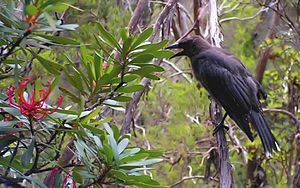
The black currawong is found only in Tasmania and is quite common there. However, it's rare or absent in areas below 200 m (660 ft) in height. They mostly breed in the Central Highlands of Tasmania. You can also find them on many islands in Bass Strait, like the Hunter and Furneaux Groups.
These birds usually stay in one place. But some populations living in high mountains might move to lower areas during the winter. Flocks have even been seen flying 20 km (12 mi) across the water from Maria Island to the mainland in the morning and returning at night.
The black currawong is listed as "Least Concern" on the IUCN Red List of Threatened Species. This means it's not currently in great danger. However, one of its subspecies, Strepera fuliginosa colei from King Island, is listed as "Vulnerable." This is because much of its forest home on King Island has been cleared. There are only about 500 of these birds left.
Black currawongs usually live in wet eucalypt forests. They also like cool rainforests and mountain scrublands. In drier, more open forests, you'll find the clinking currawong instead.
How They Behave
Black currawongs can be seen alone or in pairs. Sometimes, they gather in large groups of 20 to 80 birds. They have been seen doing interesting things, like digging wet yellow clay from a drain and rubbing it all over their feathers, almost like a dirt bath!
When they fly, they have a wavy pattern that matches their wing beats. When they land, they often lift their tail for balance. Young birds especially like to play. They've been seen wrestling, trying to push each other onto their backs. Some have even been reported rolling on their backs and juggling food like pears with their feet.
Breeding and Nests
Black currawongs breed from August to December. Like all currawongs, they build a large, cup-shaped nest from sticks. They line it with softer materials and place it in the fork of a tree, usually 3 to 20 m (10 to 66 ft) high. Sometimes, they clean up old nests and use them again the next year.
A female currawong usually lays two to four eggs. The eggs are pale grey-brown or purplish-buff with red-brown or purplish-brown spots. When the chicks hatch, they are born naked and blind. Both parents feed the young birds. After the young leave the nest, the male parent often feeds them alone. He also starts placing food on the ground nearby so they can learn to find food for themselves.
What Do They Eat?
Black currawongs are omnivores, meaning they eat both plants and animals. They eat a wide variety of foods, including insects, small animals, dead animals (carrion), and berries. They mostly look for food on the ground but also search in tree branches. They use their strong bills to poke into the ground or flip over dirt and small rocks to find hidden food.
Most often, black currawongs look for food in pairs. However, they can gather in large groups. Flocks of 100 birds have been seen visiting orchards to eat apples or rotten fruit. They are clever hunters. One parent currawong was seen wedging a dead chicken's wings under a log to make it easier to pull off pieces for its young. Another time, a bird hooked a dead rabbit on a log to rip it apart.
They eat berries from plants like Leptecophylla juniperina and Astroloma humifusum, as well as domestic peas and apples. They also eat many types of insects, such as ants, moths, flies, crickets, grasshoppers, and beetles. They've even learned to eat the introduced European wasp. They have been seen catching and eating small animals like house mouses, lizards, tadpoles, and even young chickens or ducks.
Black currawongs can become quite brave and friendly, especially in parks and gardens where people feed them. They have been known to take peas from pods, raid orchards, snatch chickens from yards, and even go into barns looking for mice.
These birds are very common around picnic areas in Tasmania's popular National Parks, like Freycinet and Cradle Mountain-Lake St Clair. Tourists often feed them there. Park authorities tried to stop this practice because the birds became a nuisance. However, the clever currawongs are good at grabbing food left by picnickers. They also sometimes take other items like soap or cutlery from campsites to investigate them.
Images for kids
-
Black currawong, Tasmania
-
Juvenile black currawong, Cradle Mountain
-
Black currawong, Fortescue Bay, Tasman Peninsula
See also
 In Spanish: Verdugo fuliginoso para niños
In Spanish: Verdugo fuliginoso para niños



